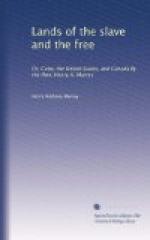There is comparatively little difficulty in finding your way about New York, or, indeed, most American towns, except it be in the old parts thereof, which are as full of twists, creeks, and names as our own. The newer part of the town is divided into avenues running nearly parallel with the Hudson; the streets cross them at right angles, and both are simply numbered; the masses of buildings which these sections form are very nearly uniform in area, and are termed blocks. The great place for lounging, or loafing, as they term it—is Broadway, which may be said to bisect New York longitudinally; the shops are very good, but, generally speaking, painfully alike, wearying the eye with sameness, when the novelty has worn off: the rivalry which exists as to the luxe of fitting up some of these shops is inconceivable.
I remember going into an ice-saloon, just before I embarked for England; the room on the ground-floor was one hundred and fifty feet long by forty broad; rows of pillars on each side were loaded to the most outrageous extent with carving and gilding, and the ceiling was to match; below that was another room, a little smaller, and rather less gaudy; both were crowded with the most tag-rag and bob-tail mixture of people.
The houses are built of brick, and generally have steps up to them, by which arrangement the area receives much more light; and many people with very fine large houses live almost exclusively in these basements, only using the other apartments for some swell party: the better class of houses, large hotels, and some of the shops, have their fronts faced with stone of a reddish brown, which has a warm and pleasant appearance. The famous “Astor House” is faced with granite, and the basement is of solid granite. The most remarkable among the new buildings is the magnificent store of Mr. Stewart—one of




